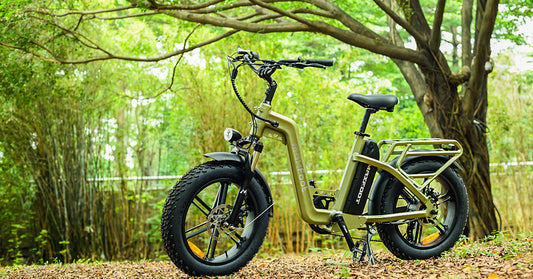The MaxFoot community has always been a vibrant and dynamic group, and in recent times, we’ve witnessed an inspiring surge in our members. As the MaxFoot community continues to grow, it’s essential that every member feels empowered, informed, and confident in their interactions and discussions.
Technical terms, often seen as jargon, can sometimes act as barriers. But, with a little guidance, they can become tools of empowerment. By understanding these terms you can contribute meaningfully to conversations, and continue the legacy of knowledge-sharing that MaxFoot prides itself on. The article aims to cover key terms you might see on specs. of all kinds of ebikes.
1. PAS (Pedal Assist System)

The PAS, short for Pedal Assist System is central to all class 2 ebikes, and our bikes come equipped with it. This innovative system augments the power from the electric motor in tandem with the rider's pedaling.
It enables riders to achieve greater speeds with less effort. The PAS levels can be adjusted. For instance, if you want to work you may set it own lower settings and vice versa. All the information regarding the assistance you’re using is displayed on the front LCD panel. An important to note here is the system only activates when you pedal, assisting your effort. It’s different from a throttle system.
2. Shifter

You might be familiar with the gear-changing mechanism in cars, where the knob is used to shift between gears. Bikes do have gears, however, they are changed through a shifter.
You will find a shifter on the right side of the handlebar. It facilitates the transition between different gears and allows riders to adapt to varying terrains. By efficiently shifting gears, riders can optimize pedaling, extend battery life, and tackle challenges like hilly terrains with ease.
3. Brake Pads and Calipers

Life is a combination of movement and pauses, and every journey how good it may be comes to an end. The braking system puts a pause on your ride. In an ebike, this system is a combination of brake pads and calipers.
When the brake levers are activated the caliper applies force to the brake pads, which then creates friction against the brake rotor. This mechanism decelerates or stops the e-bike. It's imperative to periodically inspect and maintain these components to ensure optimal braking performance and rider safety.
4. Cadence Sensor

The Cadence sensor is complimentary when you PAS in the bikes. This intuitive sensor identifies pedal movement and signals the e-bike to deliver the predetermined level of pedal assistance. It ensures a seamless integration of manual pedaling with motorized assistance.
5. Geared Hub Motor

E-bikes can have hub or mid-driver motors. The difference is the location of the motors. The first one is attached to the wheel and the later one to the frame. The hub bikes have fewer moving parts and are more durable comparable to their counterparts. Our bikes have geared hub motors.
The geared hub motor stands out for its superior force, especially during start-ups or uphill rides. This type of motor is designed for minimal maintenance and is versatile enough for both city streets and rugged trails.
6. Front Fork Suspension

Instead of a rigid front fork, Maxfoot Ebikes have a front suspension system. This component plays a pivotal role in absorbing shocks from rough terrains, ensuring a smoother and more comfortable ride for the cyclist.
7. PSI or BAR (Tire Pressure)

Pound per square, PSI, a unit for measuring tire pressure. It is crucial for an e-bike's optimal performance. The recommended pressure range is typically inscribed on the tire's sidewall. Sticking to this range ensures the right balance between grip, comfort, and efficient battery usage.
8. Derailleur

E-bikes with multiple gears, such as those equipped with the Shimano 7-speed gear system, utilize derailleurs to facilitate gear transitions. The derailleur ensures the chain shifts smoothly across the gears, optimizing the riding experience. On the other hand, single-speed e-bikes use chain tensioners. These components maintain the chain's tension, guaranteeing an efficient transfer of power from the pedals.
Conclusion
The e-bike revolution is reshaping the way we perceive transportation and adventure. These technical terms, while intricate, form the essence of our e-biking experiences. Familiarity with them enhances our rides and integrates us into a community that cherishes knowledge and empowerment.
TheMaxFoot community exemplifies the blend of passion and the spirit of exploration. When you mount your e-bike, revel in the engineering marvel beneath you and the wealth of knowledge you hold. Ride on,MaxFoot, and embrace the future of electric-assisted cycling!




